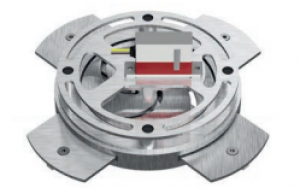- Home » Editorial » Pneumatics
New partnership aims to advance aerospace airbrakes technology

A new collaborative effort has resulted in the development of an advanced airbrakes prototype designed for aerospace applications. This project showcases the potential of joint industry expertise in enhancing rocket technology and improving flight control systems. H&P reports.
The Sapienza Aerospace Student Association (SASA) has announced a collaboration with AirTAC Europe / ATC Italia Srl. With over thirty years in the global industrial sector, AirTAC is a prominent producer of pneumatic components. This partnership will showcase the adaptability and effectiveness of AirTAC’s products within the aerospace industry, beginning with its involvement in SASA’s latest initiative: the Airbrakes Flower Prototype.
The Airbrakes Flower Prototype, an ambitious project spearheaded by SASA’s Structures, Aerodynamics, and Control Systems departments, exemplifies cutting-edge engineering. The prototype features a dual-plate structure that supports the active elements, including a disc with four guides. These guides enable the petals to extend through linear movement, creating a sophisticated airbrake system that provides passive control over the altitude of the sounding rocket, ensuring precise achievement of the target apogee.
Dimensional and performance specifications
SASA’s probe rockets are designed to accommodate various subsystems within a 10-centimetre diameter structure, including the solid propellant motor and payload housed in the ogive. The integration of aerobrakes demanded stringent size and weight constraints. The challenge was to develop a prototype with four removable wings while maintaining a compact and lightweight design, necessitating the miniaturisation of components like the rails.
Reliability in aerospace applications
Reliability is crucial in aerospace applications. The industry aims to optimise both the lightness and dependability of components, with rigorous analysis to prevent unexpected failures. For this prototype, the reliability of all components, including the rails, was thoroughly tested and validated through ground tests and digital simulations. Initial designs with a connecting rod-crank mechanism, while functional, increased the number of components and overall footprint. Streamlining these systems improves reliability by reducing the number of parts, making the system easier to manage and less prone to failure.
Technical characteristics of AirTAC guides
The primary constraint for the prototype was size. Despite their small dimensions, the guides needed to provide high mechanical performance to ensure proper operation and safety. The Structures department assessed the forces and moments the trolley would need to support, using datasheets from AirTAC to select appropriate trolleys with suitable safety margins. The chosen guides balanced footprint, mass, and mechanical properties, featuring a T variant threading to facilitate integration into the prototype.
Innovative features of the Airbrakes Flower Prototype
The primary role of the airbrake system is to slow the rocket’s ascent, enabling accurate control of the apogee. The aerobrake fins are automatically deployed through a height and speed detection system. The prototype, named "Airbrakes Flower" for its petal-like wings, draws inspiration from technologies used in international model rocket competitions, where precise apogee control is a key evaluation criterion.
The innovation of this prototype lies in its cam profile, which enhances system reliability by reducing the number of components and couplings. A hot-swap design also allows for the testing of different aperture profiles, adding to the system’s adaptability. The compact and lightweight aerobrake design reduces constraints and paves the way for future modular adaptations based on evolving project requirements.
The partnership between SASA and AirTAC Europe marks a significant step forward in aerospace engineering, highlighting the power of collaborative innovation in pushing the boundaries of technology.
For further information please visit: https://eu-en.airtac.com/
https://www.linkedin.com/company/airtac-international-group/
-
PPMA 2025
23 September, 2025, 9:30 - 25 September, 2025, 16:00
NEC, Birmingham UK -
Advanced Engineering Show 2025
29 October, 2025, 9:00 - 30 October, 2025, 16:00
NEC, Birmingham UK










